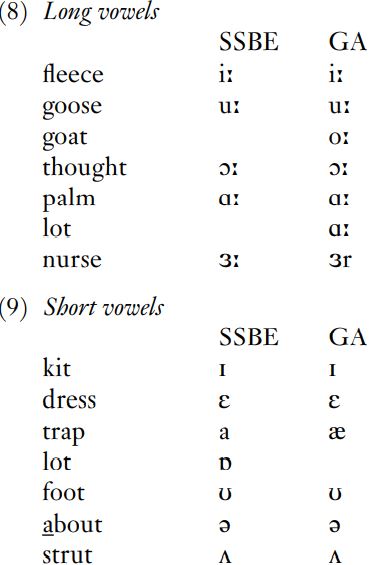
Length
 المؤلف:
April Mc Mahon
المؤلف:
April Mc Mahon
 المصدر:
An introduction of English phonology
المصدر:
An introduction of English phonology
 الجزء والصفحة:
72-6
الجزء والصفحة:
72-6
 18-3-2022
18-3-2022
 1463
1463
Length
Using these three dimensions of frontness, height and rounding, we can now define the vowel in fleece as high, front and unrounded; that in goose as high, back and rounded; and the unstressed vowel of about, schwa, as mid, central and unrounded. However, our elementary descriptions would class the kit vowel as high, front and unrounded, and the foot vowel as high, back and rounded; these labels make them indistinguishable from the clearly different vowels of fleece and goose respectively. SSBE and GA speakers very readily perceive the fleece and kit vowels, and the goose and foot vowels, as different; and there are plenty of minimal pairs to support a phoneme distinction, as in peat – pit, leap – lip, Luke – look, fool – full. This distinction is usually made in terms of vowel length: in SSBE and GA, the vowels in (8) are consistently produced as longer than those in (9).

This is not to say, however, that the only difference between [i:] and [I], or [u:] and [υ], is one of length: the quantity difference goes along with a difference in quality. [i:] is higher and fronter than [I]; [u] is higher and backer than [υ]; and similarly, [ɑ:] in palm is lower and backer than the corresponding short [a] in trap. In general, long vowels in English are more peripheral, or articulated in a more extreme and definite way, than their short counterparts. Some phonologists use a feature [±tense] rather than length to express this difference, with the long, more peripheral vowels being [+tense], and the short, more centralized ones being [– tense], or lax.
 الاكثر قراءة في Phonology
الاكثر قراءة في Phonology
 اخر الاخبار
اخر الاخبار
اخبار العتبة العباسية المقدسة


